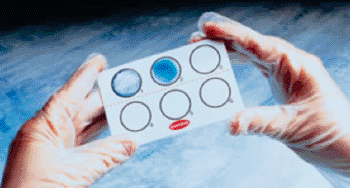Health Care Workers Carry Diarrhea Spores on Their Hands
By LabMedica International staff writers
Posted on 23 Jan 2014
It is not uncommon to find the bacteria Clostridium difficile on the hands of health care workers, highlighting a possible route through which the diarrhea causing bacteria spreads in hospitals.Posted on 23 Jan 2014
There is a view that many health care workers could be passing on C. difficile to patients, even after routine alcohol-based hand rubbing, pointing to a need for routine hand washing with soap and water after treating any infected patient, regardless of the setting.

Image: Latex agglutination test for Clostridium difficile (Photo courtesy of Oxoid).
Scientists from the Geneva University Hospitals (Switzerland) and their colleagues compared hand contamination of health care workers caring for patients infected with C. difficile with that of workers caring for non-infected patient. The prospective study was performed from June through August 2007 in a 950-bed French university hospital, at a time when the overall incidence of C. difficile infection (CDI) was 1.3 cases per 10,000 bed-days, with 68% of cases classified as hospital acquired.
The sampling of the health care workers (HCW) hands was performed using a method of spore salvage developed by the scientists. Colonies of C. difficile were initially identified by their macroscopic appearance and odor, followed by latex agglutination testing (Oxoid C. difficile Test kit, Thermo Scientific; Basingstoke, UK). During the study observation period, 7 CDI case patients and 16 control patients were included and were cared for by 66 exposed and 44 unexposed HCWs, respectively. All 110 HCWs had their hands sampled. The majority of participating HCWs were nurses and nursing assistants.
C. difficile spores were recovered from 24% (16/66) samples obtained from hands of exposed HCWs and from none (0/44) of those obtained from unexposed HCWs. A mean of two colony-forming units (CFUs) (range, one to six) of C. difficile were recovered per positive hand, with the highest numbers found following high-risk care. Contamination occurred with high-risk contact, for instance, when the health care worker did not wear gloves, or when they washed patients after fecal soiling, or following a digital rectal exam, changing soiled bed linen, or carrying out a colonoscopy. Hand contamination was also linked to duration of high-risk contact and was more common among nursing assistants whose contamination rate was 42%, than other workers such as physicians with a contamination rate of 23%, and nurses at 19%.
The authors concluded that nearly one-quarter of HCWs have hands contaminated with C. difficile spores after routine care of patients with CDI. Hand contamination is positively associated with exposure to fecal soiling and lack of glove use. Caroline Landelle, PharmD, PhD, the lead author of the study said, “Because C. difficile spores are so resistant and persistent to disinfection, glove use is not an absolute barrier against the contamination of health care workers' hands. Effective hand hygiene should be performed, even in nonoutbreak settings.” The study was published on November 26, 2013, in the journal Infection Control and Hospital Epidemiology.
Related Links:
Geneva University Hospitals
Oxoid







 assay.jpg)





